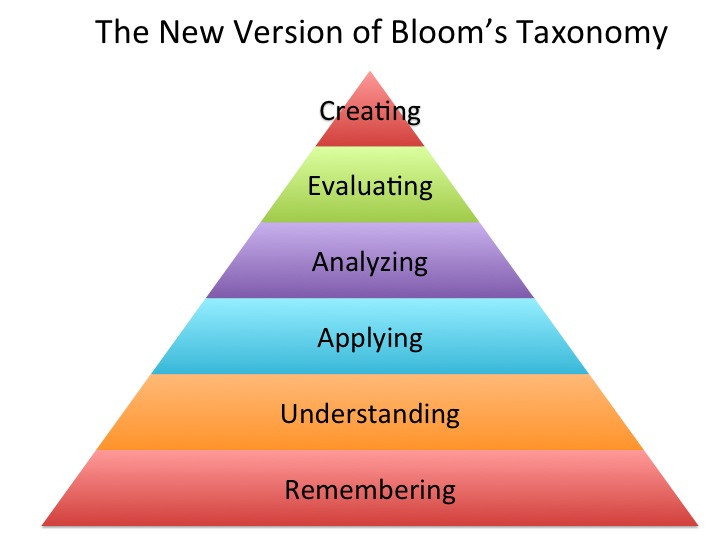
Bloom’s taxonomy has been recently revised and now has “CREATE” knowledge at the top of the learning pyramid.
Though application of knowledge is needed and is an essential component of critical thinking, this level of knowledge acquisition is only third out of six cognitive domains of learning.
In order to strengthen student learning, students must not only USE knowledge but also CREATE it.
How can educators guide students to CREATE knowledge consistently in the classroom?
In this blog I will share a simple strategy to make it possible to CREATE knowledge to strengthen student learning in your class or clinical post-conference setting!
Bloom’s Review
There are currently six levels of cognitive knowledge domains that represent progressive complexity of learning.The highest level of Bloom’s was EVALUATION. Evaluation is now one step down and the highest level that has been added is CREATE.
The goal is to move upwards on the domain to strengthen student learning. This level of learning will also prepare students for the NCLEX® as well as clinical practice.
If students are able to master only the lower cognitive domains, they will struggle. Therefore educators need to START with lower level domains, but be intentional to move students upward so they can USE, APPLY as well as CREATE knowledge.
The six cognitive domains and the most common verbs to describe each domain of learning beginning with the lower or base of the cognitive learning pyramid include:
- Remember: recognizing, recalling
- Understand: interpreting, classifying, summarizing, comparing, explaining
- Apply: executing, carrying out
- Analyze: differentiating, organizing
- Evaluate: checking, critiquing
- Create: generating, planning/designing, producing/constructing
Struggles in the Classroom
In order to transform nursing education, classroom learning must be contextualized to clinical practice and bring clinical realities to the classroom. This continues to be an ongoing challenge to nursing education (see prior blog Why Classroom Learning Must Be Active).
One of the greatest struggles of nurse educators in the classroom is to ENGAGE students and be an active participant in their learning.
But to build on these needed paradigm shifts to transform nursing education, knowledge must also be CREATED.
Case studies that emphasize clinical reasoning are an effective strategy to bring ACTIVE learning to your classroom and a great place to start.
My unique clinical reasoning case studies can also be used to CREATE and CONSTRUCT knowledge by doing a couple of things differently!
Preparing the Way to CREATE Knowledge
To get started, do the following to prepare the way:
- Students must first be able to have a DEEP knowledge of the MOST important content so they are able to USE knowledge. Make it a priority to emphasize the NEED to know content so this level of learning can be realized (see prior blog What Every Lecture Must Cover). This will involve the lower level domains of REMEMBERING and UNDERSTANDING Bloom’s.
- Have students then utilize the third domain of Bloom’s by APPLYING knowledge. Using Active learning tools including case studies is a practical way to move up to this level of learning.
HOW to CREATE
Once you have laid the foundation with deep learning of what is most important and applying that knowledge, now it is time to CREATE learning!
Here are the steps needed to go straight to the top of Bloom’s!
Once you have presented the content (either by textbook reading, classroom lecture, or online delivery) do the following:
- Give your students a BLANK template of a case study. I recommend using my templates of clinical reasoning case studies that are a FREE download on my site and will have this download included in today’s blog!
- I have FOUR complementary levels of case studies on my site, but each case study has the following components that must be addressed:
- Opening scenario…what is the problem?
- Initial VS and nursing assessment by body system
- Lab panels and diagnostic tests
- Medical management: What orders would care provider order to manage problem?
- Clinical reasoning questions
- Print up the template to have students write in directly, or since it is a Word doc., have students use the Word doc. template on their computer to fill in the case study. This is where the CREATION of knowledge occurs. Students must now take the knowledge that they have been presented and use it to write a typical scenario of the problem that is being covered in class, EXPECTED ABNORMAL findings in the VS, assessment, and labs. as well as what will the physician order to manage this problem and the rationale.
- This is only the beginning! Once this aspect of the case study has been created by students, they now need to THINK like a nurse and answer the clinical reasoning questions that represent the essence of nurse thinking.
- Go all the way! Have students share their case study in class and present the scenario with clinical data. Have the rest of the class answer the clinical reasoning questions. You as the educator are now the “guide on the side” as you facilitate the learning process in your classroom!
In Closing
In order to transform nursing education a curriculum change is not required. Instead nurse educators must simply change the way they teach!
I have developed my unique clinical reasoning case studies to serve the needs of time strapped nurse educators so they can bring this needed change!
Use these clinical reasoning case study templates and decide which one works best for you and your students level of learning. With these case study templates, educators can engage and make students active participants in their learning.
Better yet they are also using the highest cognitive domain of creating knowledge.
This level of mastery will not only strengthen student learning for the NCLEX®, but more importantly prepare them for clinical practice!
Though it is the middle of the semester, do something differently and take that first step and make the creation of knowledge the “new normal” in your classroom this semester!
What do you think?
What strategies have you used to have students CREATE knowledge in your program?
Comment below and let the conversation begin!
ACTION Steps to Today’s Blog!
To make today’s topic concrete, I recommend the following steps:
- Download the Word doc. template in this blog post
- Post this case study template one week ahead of time with guidelines or work together in class together in small groups
- Have students share what they have created in class
- SHARE this blog post on your social media channels! Click your preferred channel at the top or bottom of today’s blog to be an advocate for needed change in nursing education!
Keith Rischer – PhD, RN, CEN
As a nurse with over 35 years of experience who remained in practice as an educator, I’ve witnessed the gap between how nursing is taught and how it is practiced, and I decided to do something about it! Read more…
The Ultimate Solution to Develop Clinical Judgment Skills
KeithRN’s Think Like a Nurse Membership
Access exclusive active learning resources for faculty and students, including KeithRN Case Studies, making it your go-to resource.



